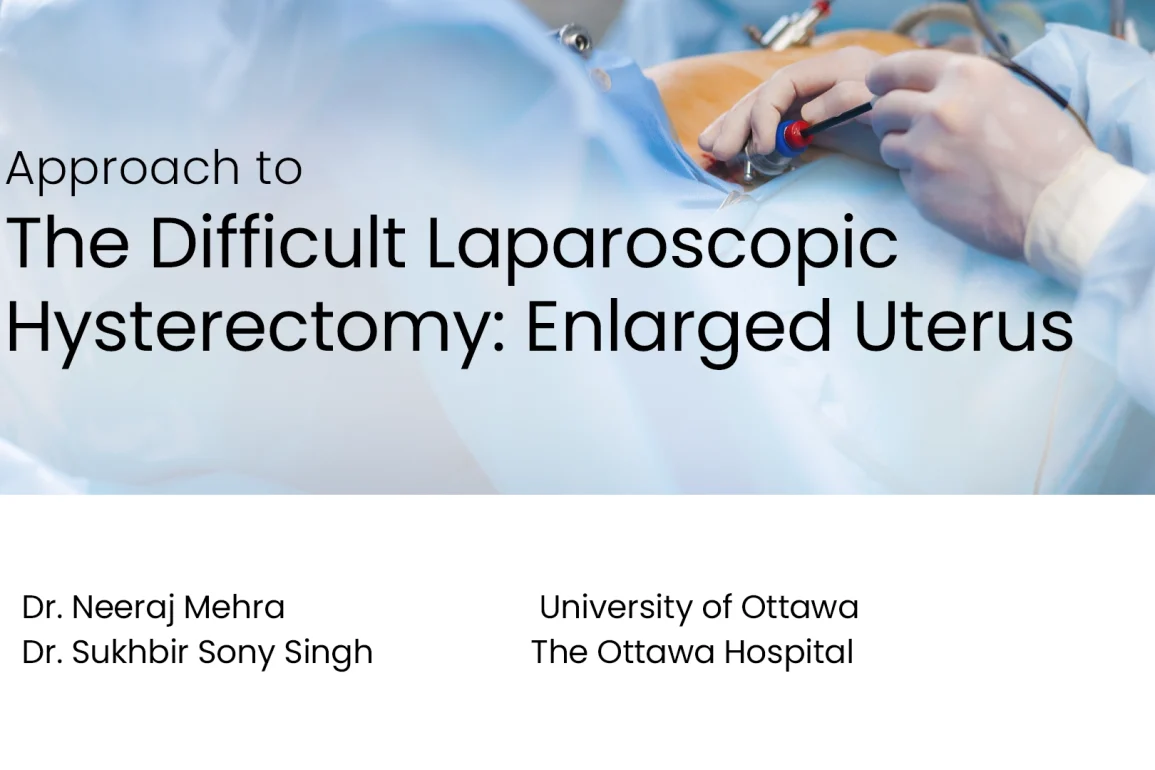Table of Contents
Summary
- This is an educational video in a series of videos discussing laparoscopic hysterectomy.
- The focus of this video is on the approach to dealing with an enlarged uterus.
- Traditional teaching would suggest that laparotomy is the best option for an enlarged uterus, but a vaginal or laparoscopic approach can also be effective.
- Six steps are highlighted for dealing with an enlarged uterus, including preoperative assessment, optimising visualisation, and securing uterine vessels.
- A systematic and efficient approach can facilitate success at laparoscopic hysterectomy, even with an enlarged uterus.
Presented By
- Dr. Neeraj Mehra
- Dr. Sukhbir Sony Singh
Affiliations
University of Ottawa, The Ottawa Hospital
See Also
Laparoscopic Hysterectomy Definition
- Laparoscopic hysterectomy is a minimally invasive surgery to remove the uterus.
- It involves using a laparoscope (a small camera) and other surgical instruments inserted through small incisions in the lower abdomen.
- Compared to open hysterectomy, it has benefits like less pain, lower risk of infection, quicker recovery times, and less scarring.
- There are different types, including total laparoscopic hysterectomy, laparoscopic-assisted vaginal hysterectomy, and laparoscopic supracervical hysterectomy.
Watch on YouTube
Video Transcripts
This is a presentation of the University of Ottawa in the Invasive Surgery Programme. This is an educational video in a series of videos, Understanding a Surgical Approach to Difficult Laparoscopic Hysterectomy. In this video, we will discuss our approach to dealing with the enlarged uterus. For the purpose of this video, an enlarged uterus is defined any uterus that is large enough such that the visualisation of a normal anatomy required to perform a laparoscopic hysterectomy is obscured.
Hysterectomy Techniques
Traditional teaching would suggest that the enlarged uterus is best managed with laparotomy. However, theories exist that show a vaginal hysterectomy may be possible in expert hands. The laparoscopic approach has also been demonstrated to be effective, but requires a method that will facilitate success. Thus, with good surgical technique, laparoscopic hysterectomy is feasible and safe, regardless of uterine weight.
Six Steps to Dealing with the Enlarged Uterus
We highlight six steps to dealing with the enlarged uterus.
Step One – Preoperative Assessment and Decision Making
In the office, a good history and physical exam will be the start to succeed in these cases. Examination should be done with a procedure approach mind. Some key features to look for that will affect the surgical approach include uterine size, uterine mobility, lower segment width wear, presence of cervical and lower uterine masses can make it more difficult to access the uterine vessels.
Concomitant diagnoses, such as endometriosis or adnexal masses. Finally, other patient parameters, such as body mass index and previous surgery. Consideration should also be made to preoperative optimisation of anaemia and uterine size, which can be facilitated with use of GnRH agonists.
Step Two – Optimise Visualisation
When dealing with the enlarged uterus, laparoscopic ports can be placed higher than normal in order to adequately visualise the uterus and improve instrument access. Frequently, a left-upper quadrant insertion is also required. Once inside the abdomen, a 30-degree laparoscope is essential to visualise around the obstructing uterus.
Step Three – Early Intraoperative Assessment
Really exploration of the abdomen and pelvis is important before embarking on extensive surgical dissection. A thorough assessment can help the surgeon anticipate difficulties, make key decisions regarding surgical approach and recognise the potential for conversion to laparotomy.
This assessment involves looking at four compartments. The lateral compartments determine access to the ileum and utero-ovarian pedicles. The posterior compartment determines access to the cul-de-sac. The anterior compartment examines the bladder flap. The middle compartment examines the lower uterine segment to determine access to the uterine vessels. Finally, an overall assessment of size, shape and location of fibroids is carried out.
Step Four – Mobilise Ligaments and Pedicles
Sequentially, all pedicles, including round ligaments, utero-ovarian ligaments and bladder flap are mobilised. A vaginal cyst is pushing up on the uterus. As pedicles are released, uterine mobility will improve and more difficult areas to reach can now be accessed.
Step Five – Secure Uterine Vessels Proximally
When securing the uterine vessels, attention be made to the fact that these vessels can be larger than a normal-sized uterus, with the potential to encounter significant bleeding. With a very large uterus, proximal ligation of the uterine arteries should be considered as an alternative, as it may significantly help improvable hemostasis.
Step Six – Morcellation and Specimen Removal
Depending on the surgery performed, various morcellation methods can be employed. With a total laparoscopic hysterectomy, the uterus can be morcellated vaginally using various techniques. If a subtotal hysterectomy is performed, laparoscopic morcellation can be carried out. However, this method can be time consuming, specially with a large uterus.
Alternatively, we employ the use of a four-centimetre mini laparotomy incision, for placement, a small, self-retaining retractor. The uterus can then be morcellated safely and efficiently with little patient impact compared to other methods.
Conclusion
To conclude, these six key steps provide systematic and efficient approach to dealing with the enlarged uterus, and when carried out routinely can facilitate success at laparoscopic hysterectomy.


